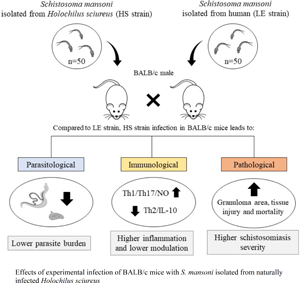Published online by Cambridge University Press: 01 June 2022

Wild mammals, especially rodents, can participate in the life cycle of Schistosoma mansoni; however, the impact of these parasite strains on the severity of schistosomiasis remains unclear. The aim of this study was to comparatively evaluate the parasitological and immunopathological alterations induced by an S. mansoni strain isolated from the wild rodent Holochilus sciureus (HS strain) and a parasite strain isolated from a human (LE strain) in experimentally infected mice. Male BALB/c mice were subcutaneously infected with 50 cercariae/mouse of either the HS or the LE strain and were evaluated for 12 weeks. In the experimental groups, the parasite burden was estimated by worm and egg (feces and tissues) count, and immunopathological alterations were evaluated in the liver and intestines. Compared to experimental infection with the LE parasite strain, HS-infected mice showed reduced number of parasite worms but higher fecundity rate, significant reduction in IL-5, IL-10 and IL-13 concentrations, lower EPO-activity in liver homogenate and higher concentrations of TNF-α, IFN-γ, IL-12 and IL-17 in the small intestine homogenate. Moreover, HS infection resulted in higher concentrations of NO end-products in both the liver and intestine, suggesting a predominance of the Th1/Th17 immune response. HS-infected mice also showed higher plasma transaminase levels, formed larger granulomas, and had a higher mortality rate in comparison with LE-infected mice. Data indicate that BALB/c mice infected with the HS strain of S. mansoni showed reduced susceptibility to the parasite but stronger tissue inflammation and high disease severity.